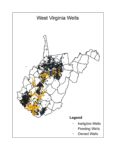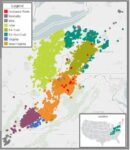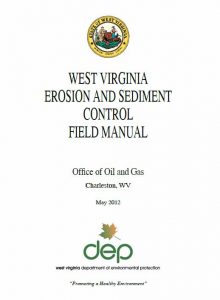Download or view The West Virginia Erosion and Sediment Control Field Manual of the West Virginia Office of Oil and Gas [updated May 2012]. You can get a paper copy of the Manual by ordering a paper copy of the West Virginia Surface Owners’ Guide to Oil and Gas.
Technically the Manual presents “best management practices”. But according to the Manual, “These [best management] practices are required” by the State.
This manual is therefore important to Surface Owners for two reasons.
First, even after a well has been drilled and the well site and access road have been re-vegetated, the driller has to keep the access road and well site in compliance with this Manual. See Section V in particular.
So if there are problems with the access road or well site on your surface, and if those problems violate the requirements of this Manual, there is something you should be able to do. Take pictures of the problems and contact the State Office of Oil and Gas. You should be able to get them to come out and see the problem, or you can e-mail them electronic pictures of the problem. If the state inspector agrees there is a problem, he should make the driller fix it. If not, contact WV SORO or a lawyer.
There is a second reason that this Manual is important to surface owners.
When surface owners learn that a driller is going to put well site and access road on their surface in order to drill an oil and gas well, what they often care most about is the location of the well site and access road. The location most favorable to the driller often conflicts with the surface owner’s preferences and plans.
The State cannot directly help the surface owner move the well site and road just based on surface owner preference or the surface owner’s “reasonably necessary” rights . (See the link called “I just got a notice of a driller’s application for a permit to drill a well on my land. What should I do?”). The grounds upon which the State can force a well site and/or access road to be moved, and the grounds upon which the surface owner can comment to the State, are limited. However, one of the important grounds upon which the State for force a well site and/or access road to be changed, and one of the things upon which surface owners can comment upon is if, “The plan for soil erosion and sediment control is not adequate or effective,” for the well site or road.
If the surface owner can show that the plan for soil erosion and sediment control for the proposed access road and well site is not adequate or effective, then the surface owner can get the State to make the driller to do it right. What is more important, finding problems with the soil erosion and sediment control plan may possibly force the relocation of the well site or access road. For example, if the case can be made that a particular well site or access road is in an area that is too wet or steep to allow for an adequate or effective plan for soil erosion and sediment control, it will have to be moved. Even if changing the location of the well site and access road is not what the surface owner wants, the surface owner’s ability to force such a change is bargaining leverage for what the surface owner does want.
Section II is the most important part of the Manual to the surface owner at the time of commenting on the permit. A form WW-9 and its attached maps and drawings comes to the surface owner with the driller’s application for a permit to drill an Oil or gas well. (There is a sample at the beginning of the Manual.) The surface owner should compare the Form WW-9 that comes with the driller’s permit application with the requirements in Section II of the Manual. If it is inconsistent, comment on that to the state to get it changed, or to get bargaining leverage to change something else the surface owner wants.
Note that the State may grant “variances” from the requirements in the Manual for a particular well site. The surface owner should look at the driller’s plan carefully to see if there are variances requested, and if those requests are for good reason – and to see if the plan has a variance from the requirements of the Manual that is not stated as such. The surface owner should attack these problems with comments – particularly if the variances are not equally effective in controlling soil erosion and sedimentation.
One good issue to look for is the steepness of roads. Steep roads are much more prone to erosion and escape of sediment into streams etc. so there are limits on steepness.
Look to see if the driller’s plan on the WW-9 and its attachments includes roads which exceed the 20% maximum grade allowed on Page 7 in Section II.A.1.a.(1) . (A 100% grade would be a 45 degree angle. A 0% grade would be level.) Note that the Manual allows the State to grant a wavier to allow steeper grades than 20% on a permit by permit basis. But allowing a waiver just for the driller to save the cost of building a longer road with a grade that is less steep should not be enough reason to grant a waiver. It is very hard to control erosion on roads steeper than 20% – particularly over the decades of the life of the well. A surface owner should think long and hard before agreeing to a steeper slope. On the other hand, to avoid having steep slopes the road will have to be longer. If the driller wants the surface owner to sign off on a plan that includes such a waiver, then the surface owner should get something in return. Or the surface owner should insist on moving the well site or access road location to locations that allow for compliance with the requirements of the Manual.
Another important thing to look at is on Page 8, Section 3 regarding water bars and cross drains that have to be placed on hilly sections of the road in order to divert water off the roads so the water will not run for long distances down the road and cause erosion. These are in addition to the ditches along the roads and the culverts under the roads. These water bars/cross drains are important in order to prevent erosion, and the driller’s plan will often not use enough of them, or put them at the wrong angles to the slope, or not make them tall enough or not maintain them.
If you have not already done so, in order to get a more detailed explanation of surface owners’ rights click here to get a copy of the West Virginia Surface Owners Guide to Oil and Gas. You also receive a paper copy of the Erosion and Sediment Control Manual if you order paper copy of the West Virginia Surface Owners’ Guide to Oil and Gas.










